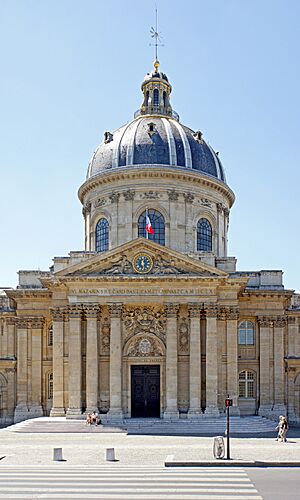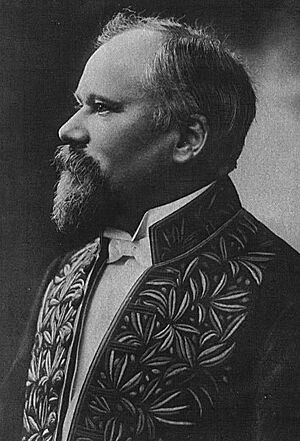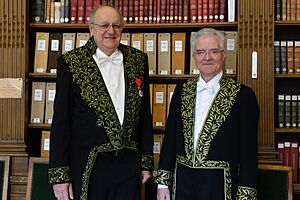Académie Française facts for kids

Institut de France building
|
|
| Formation | 22 February 1635 |
|---|---|
| Founder | Cardinal Richelieu |
| Headquarters | Paris, France |
|
Membership
|
40 members known as les immortels ("the immortals") |
|
Perpetual Secretary
|
Amin Maalouf (since 28 September 2023) |
The Académie Française, also known as the French Academy, is a very important group in France. It focuses on everything about the French language. This Academy was officially started in 1635 by Cardinal Richelieu. He was the main advisor to King Louis XIII.
The Academy was closed down in 1793 during the French Revolution. But it was brought back in 1803 by Napoleon Bonaparte. It became a part of the Institut de France. The Académie Française is the oldest of the five academies in this institute. Its main job is to be the official expert on the French language. It also publishes the official dictionary of the language.
The Académie has forty members. They are known as les immortels, which means "the immortals." New members are chosen by the current members of the Academy. Once elected, members usually stay for life. However, they can resign or be removed if they do something wrong. For example, Philippe Pétain was elected in 1931. But he was forced to leave in 1945 because of his actions during World War II.
Contents
The Academy's Story

The Académie started as a casual group of writers. They met in homes in Paris in the late 1620s and early 1630s. This group wanted to keep their meetings informal. There were nine members at first.
Cardinal Richelieu, who was a powerful minister in France, became their supporter. In 1634, new members joined as the Academy was getting ready to become official. On February 22, 1635, King Louis XIII formally approved the group. This was thanks to Richelieu's encouragement. The goal of the Académie Française was "to work with all possible care and effort, to give exact rules to our language, to make it able to discuss arts and sciences." Since then, the Académie Française has been in charge of French grammar, spelling, and literature.
Richelieu was inspired by the Accademia della Crusca. This Italian academy was founded in Florence in 1582. It helped make the Florentine way of speaking the standard for the Italian language. That academy had published its dictionary in 1612.
During the French Revolution, all royal academies were closed. This included the Académie Française. In 1792, they stopped electing new members. In 1793, the academies were completely shut down. They were replaced in 1795 by a single group called the Institut de France.
Napoleon Bonaparte later decided to bring back the old academies. But he made them "classes" or parts of the Institut de France. The second class of the Institut was for the French language. This was like the old Académie Française. When King Louis XVIII became king in 1816, each class got its "Académie" title back. So, the second class became the Académie Française again. Since 1816, the Académie Française has continued without interruption.
The President of France is the "protector" or patron of the Académie. Cardinal Richelieu first held this role. After he died in 1642, Pierre Séguier took over. King Louis XIV became the protector in 1672. Since then, the French head of state has always been the Académie's protector. From 1672 to 1805, the Académie met in the Louvre. Since 1805, the Académie Française has met in the Collège des Quatre-Nations. This building is now known as the Palais de l'Institut. Other academies of the Institut de France also meet there.
Who Are the Members?
The Académie Française has forty seats, each with its own number. People who want to join apply for a specific seat. If there are several empty seats, a person can apply for each one. New members must give a speech praising the person they are replacing. Because of this, some people might not apply for a seat if they don't like the previous member.
Members are called "les immortels" ("the Immortals"). This name comes from the Académie's motto, À l'immortalité ("To Immortality"). This motto is written on the official seal given by Cardinal Richelieu.
One of the immortels is chosen by the others to be the Académie's Perpetual Secretary. This Secretary serves for life, but can resign. They are the main leader and representative of the Académie. Two other officers, a Director and a Chancellor, are elected for three months. The oldest member, based on when they were elected, is the Dean of the Académie.
New members are chosen by the Académie itself. The first members were appointed. When a seat becomes empty, a person can apply to the Secretary. Or, existing members can suggest other candidates. A candidate is elected if they get most of the votes from the members. At least twenty members must vote for the election to be valid. If no one gets enough votes, another election happens later. The election is only official if the President of France approves it. This approval is usually just a formality.

The new member is then officially welcomed at an Académie meeting. The new member gives a speech that includes a eulogy for the person they are replacing. Then, another member gives a speech. Eight days later, a public event is held. The new member gives a speech thanking their colleagues for electing them.
Members stay in the Académie for life. The council can remove a member for serious bad behavior. The first time this happened was in 1638. Auger de Moléon de Granier was removed for theft. The most recent removals happened after World War II. Philippe Pétain, Abel Bonnard, Abel Hermant, and Charles Maurras were all removed. This was because of their connection to the Vichy government. In total, 20 members have been expelled from the Académie.
There have been 742 immortels in total. Eleven of them have been women. Marguerite Yourcenar was the first woman elected in 1980. People who are not French citizens can also be elected. Most members are writers, but you don't have to be a writer to join. The Académie has included politicians, lawyers, scientists, historians, philosophers, and religious leaders. Five French heads of state have been members. These include Adolphe Thiers and Raymond Poincaré. One foreign head of state, Léopold Sédar Senghor from Senegal, was also a member. He was the first African elected in 1983. Other famous members include Voltaire, Victor Hugo, and Louis Pasteur.
Many famous French writers have not become members of the Académie Française. In 1855, the writer Arsène Houssaye created the term "forty-first seat." This was for talented people who were never elected. This could be because they were rejected, never applied, or died before a spot opened. Some famous authors who never joined include Jean-Jacques Rousseau, Jean-Paul Sartre, Honoré de Balzac, Molière, and Jules Verne.
The Green Uniform
The official uniform for members is called l'habit vert, or "the green clothing." This green uniform is worn at the Académie's formal events. It was first used when Napoleon Bonaparte reorganized the Institut de France. It includes a long black coat and a black hat with two points. Both are decorated with green leaf designs. Members also wear black trousers or a skirt. Also, members who are not clergy carry a ceremonial sword.
Members pay for their own uniforms. The robes can cost a lot of money. The swords can be especially expensive because they are designed for each person. Some new members have had help from groups to pay for their uniforms.
The Academy's Role for the French Language

The Académie is France's official expert on how the French language is used. This includes its words and grammar.
The Dictionary
The Académie publishes a dictionary of the French language. It is called the Dictionnaire de l'Académie française. A special group of members from the Académie creates this dictionary.
The Académie has published fourteen versions of the dictionary. Nine of these were complete editions. The most recent, the ninth edition, was finished in 2024. Its first part came out in 1992.
English Words in French
Over the years, more and more English words have been used in French media. The Académie has tried to stop French from becoming too much like English. For example, the Académie has suggested not using English words like walkman or computer. Instead, they suggest using new French words. For walkman, they suggest baladeur. For computer, they suggest ordinateur. For software, they suggest logiciel, and for e-mail, courriel.
The Académie also knows that English words have been in French since the 1700s. They don't think English words are an "invasion" of the French language. They divide English words into three types:
- Some are helpful and fill a gap in French, like "confortable" (from "comfortable").
- Others are harmful because they change the original meaning of a French word.
- Some are useless or can be avoided. These are often used by people who want to seem "trendy." The Académie says these words usually don't last long in French.
The Académie Française has told government officials to stop using English gaming terms. For example, "e-sports" should be "jeu video de competition." Also, "streamer" should be "joueur-animateur en direct."
Being Too Traditional?
The Académie has sometimes been criticized for being too traditional. This is even though they work on updating French spelling. For example, in 1997, the government started using "la ministre" for a female minister. This followed practices in Canada, Belgium, and Switzerland. But the Académie insisted on using "le ministre" for ministers of any gender. This was based on old French grammar rules. In 2017, many linguists spoke out against the Académie. They said it was "incompetent and out of date." Using either form is still a debated topic.
Awards and Prizes
The Académie Française gives out many different awards. These are for achievements in areas like literature, painting, poetry, theater, and history. Most of these awards were created in the 1900s. Only two awards existed before 1780. In total, the Académie gives more than sixty awards, mostly every year.
The most important award is the Grand prix de la francophonie. It started in 1986. It is funded by the governments of France, Canada, Monaco, and Morocco. Other important awards include the Grand prix de littérature (for a literary work) and the grand prix du roman (for a novel). There is also the Grand prix de poésie de l'Académie française (for poetry) and the grand prix Gobert (for French history).
Against Regional Languages
In June 2008, the Académie Française spoke out against a government plan. This plan wanted to officially recognize and protect regional languages in France. These languages include Flemish, Alsatian, Basque, Breton, and Catalan.
Current Members
As of August 2025, the Académie Française has 40 members, including Amin Maalouf as the Perpetual Secretary. The members are elected for life and come from various fields, not just writing.
See also
 In Spanish: Academia Francesa para niños
In Spanish: Academia Francesa para niños
- Academy of sciences
- Conseil international de la langue française
- Former prizes awarded by the Académie française
- French art salons and academies
- Language policy in France
- List of language regulators
- Language council
- Montyon Prize – prizes awarded annually by the Académie française and the Académie des sciences
- Office québécois de la langue française
- Proposals for an English Academy
- Royal Spanish Academy
- Swedish Academy


